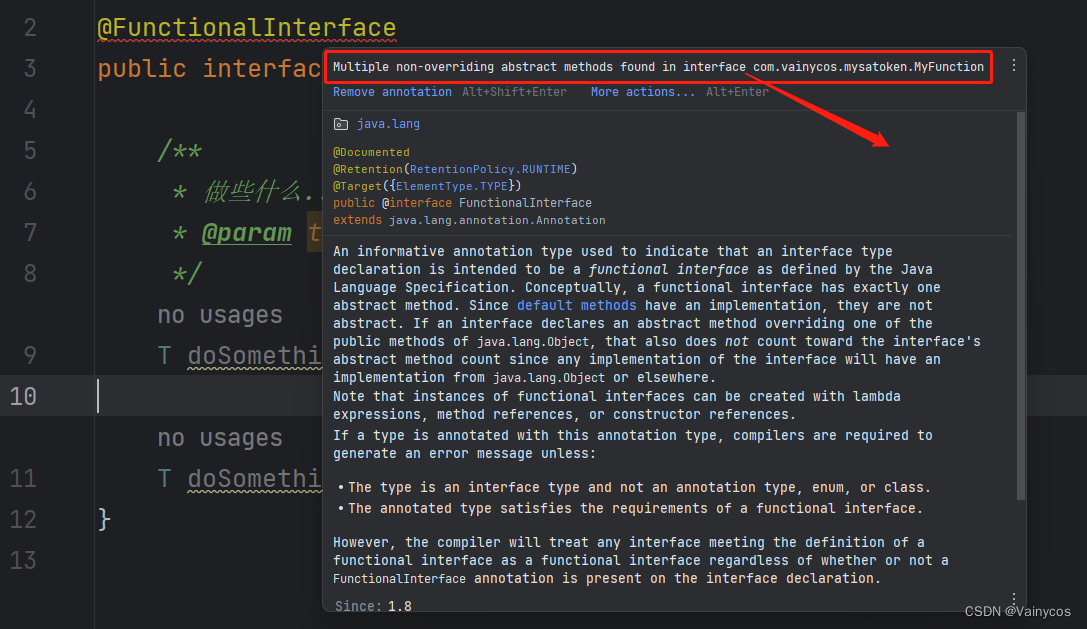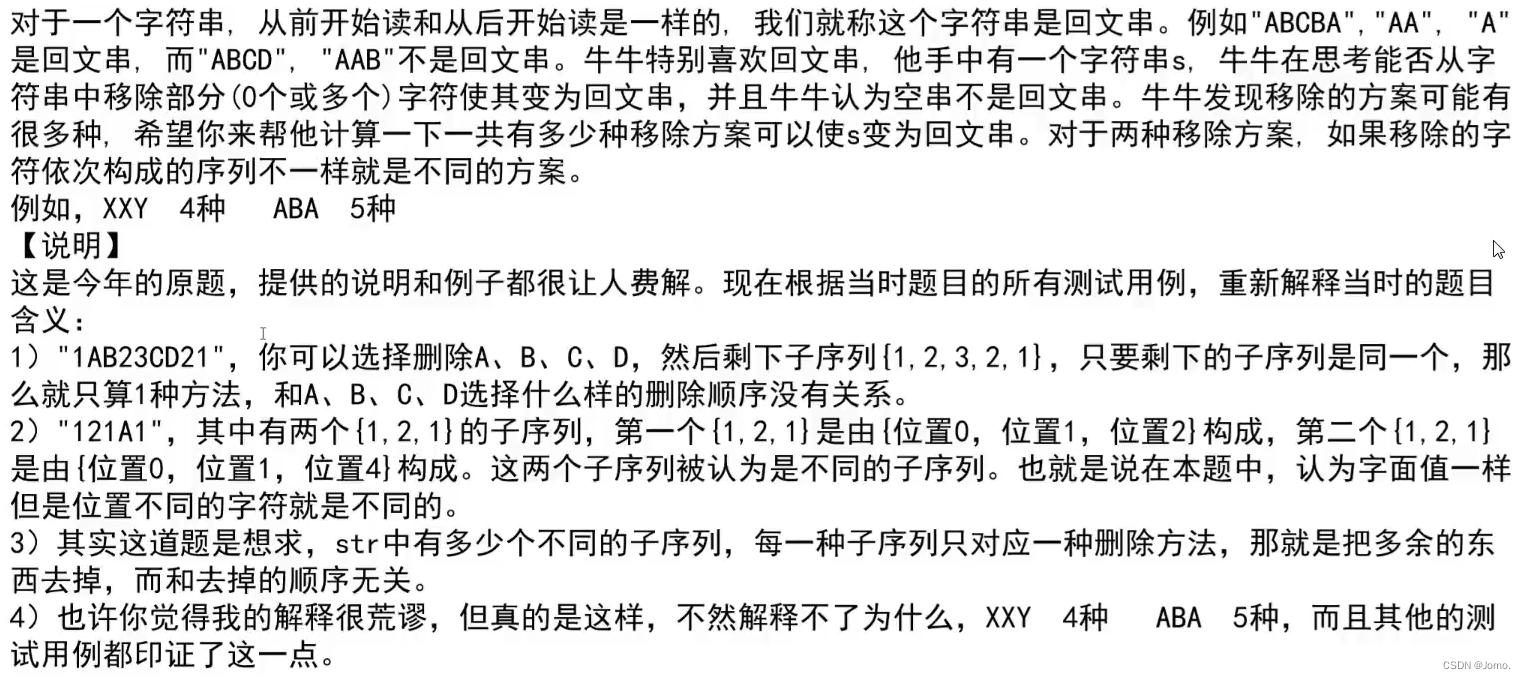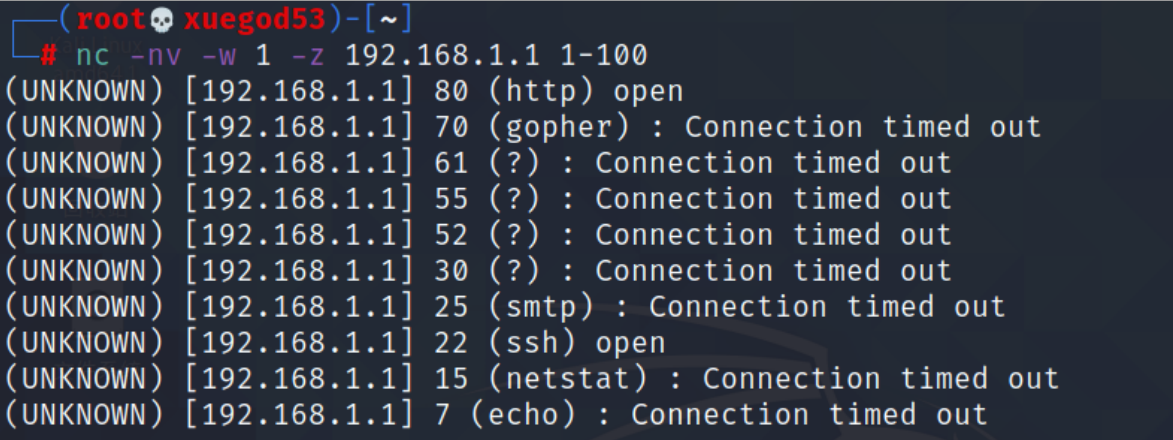文章目录
- 1. BIO简介
- BIO chain
- BIO数据结构
- BIO_METHOD数据结构
- 2. Base64示例分析
- 初始化
- 构造BIO链
- 写数据
- free
1. BIO简介
相关文档
/html/man7/bio.html
/html/man3/BIO_*.html
bio - Basic I/O abstraction,即IO抽象层。
BIO有两种:
- source/sink BIO,即数据源,如socket BIO、file BIO,初始化接口以
BIO_s_开头; - filter BIO,过滤器,用来接收和传递数据,初始化接口以
BIO_f_开头;
BIO chain
BIO可以组成一条链,即使是单个BIO,实质也是有一个节点的链。
一个链通常由1个source/sink BIO、1个或多个filter BIO组成。
数据从第一个BIO写入或读出,并传递到最后一个节点(通常是source/sink BIO)。
相关api:
- BIO_push
- BIO_free_all 释放整个链
BIO数据结构
源码位置:\crypto\bio\bio_local.h
struct bio_st {
// BIO_new初始化需要提供libctx和method参数
// BIO *BIO_new(const BIO_METHOD *method)
// {
// return BIO_new_ex(NULL, method);
// }
OSSL_LIB_CTX *libctx; // NULL: default contextz
const BIO_METHOD *method;
/* bio, mode, argp, argi, argl, ret */
#ifndef OPENSSL_NO_DEPRECATED_3_0
BIO_callback_fn callback;
#endif
BIO_callback_fn_ex callback_ex;
char *cb_arg; /* first argument for the callback */
// 这里用int来作标志应该有点浪费
// 用bool或bit更好些
int init; // 初始化标志
int shutdown;
int flags; /* extra storage */
int retry_reason;
int num;
void *ptr; // BIO_set_data()
// bio链本质是双向链表
struct bio_st *next_bio; /* used by filter BIOs */
struct bio_st *prev_bio; /* used by filter BIOs */
CRYPTO_REF_COUNT references;
uint64_t num_read;
uint64_t num_write;
CRYPTO_EX_DATA ex_data;
CRYPTO_RWLOCK *lock; // 线程读写锁
};
BIO_METHOD数据结构
源码路径:\include\internal\bio.h
struct bio_method_st {
int type;
char *name;
int (*bwrite) (BIO *, const char *, size_t, size_t *);
int (*bwrite_old) (BIO *, const char *, int);
int (*bread) (BIO *, char *, size_t, size_t *);
int (*bread_old) (BIO *, char *, int);
int (*bputs) (BIO *, const char *);
int (*bgets) (BIO *, char *, int);
long (*ctrl) (BIO *, int, long, void *);
int (*create) (BIO *);
int (*destroy) (BIO *);
long (*callback_ctrl) (BIO *, int, BIO_info_cb *);
};
该结构除了类型和名称,其余均是函数指针。
2. Base64示例分析
借用官网Base64示例:https://www.openssl.org/docs/man3.0/man3/BIO_f_base64.html,它将"hello world \n"的base64输出到stdout:
#include <iostream>
#include <openssl/bio.h>
#include <openssl/evp.h>
int main()
{
BIO* bio, * b64;
char message[] = "Hello World \n";
b64 = BIO_new(BIO_f_base64());
bio = BIO_new_fp(stdout, BIO_NOCLOSE);
BIO_push(b64, bio);
BIO_write(b64, message, strlen(message));
BIO_flush(b64);
// SGVsbG8gV29ybGQgCg==
BIO_free_all(b64);
getchar();
return 0;
}
用vscode在源码目录搜索“base64”,并没有找到实现源码,于是全局搜索编码表,定位到源码路径:
// \crypto\evp\encode.c
static const unsigned char data_bin2ascii[65] =
"ABCDEFGHIJKLMNOPQRSTUVWXYZabcdefghijklmnopqrstuvwxyz0123456789+/";
把encode.c拖到vs中,在引用编码表的地方下断点,调试示例程序,成功断下:
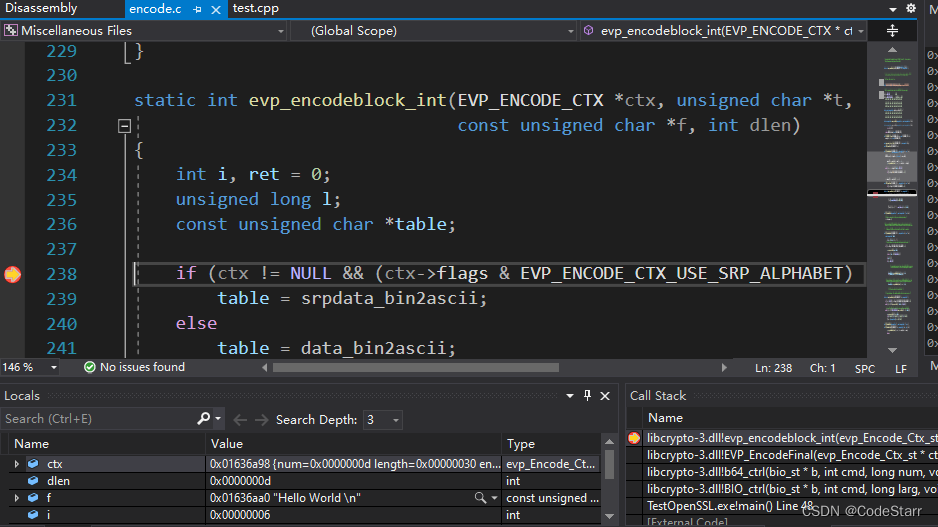
BIO_flush调用栈如下:
libcrypto-3.dll!evp_encodeblock_int(evp_Encode_Ctx_st * ctx, unsigned char * t, const unsigned char * f, int dlen) Line 238 C
libcrypto-3.dll!EVP_EncodeFinal(evp_Encode_Ctx_st * ctx, unsigned char * out, int * outl) Line 222 C
libcrypto-3.dll!b64_ctrl(bio_st * b, int cmd, long num, void * ptr) Line 506 C
libcrypto-3.dll!BIO_ctrl(bio_st * b, int cmd, long larg, void * parg) Line 579 C
TestOpenSSL.exe!main() Line 48 C++
EVP是OpenSSL的算法实现接口,结合evp文档(/html/man7/evp.html),这里正是base64编解码逻辑:
The EVP_EncodeXXX and EVP_DecodeXXX functions implement base 64 encoding and decoding.
初始化
b64 = BIO_new(BIO_f_base64());
bio = BIO_new_fp(stdout, BIO_NOCLOSE);
BIO_new_fp(),内部其实是调用了BIO_new(BIO_s_file())初始化一个source/sink BIO。所以只分析第一个base64 filter BIO。
BIO_f_base64()返回一个base64的静态BIO_METHOD:
// \crypto\evp\bio_b64.c
static const BIO_METHOD methods_b64 = {
BIO_TYPE_BASE64,
"base64 encoding",
bwrite_conv,
b64_write,
bread_conv,
b64_read,
b64_puts,
NULL, /* b64_gets, */
b64_ctrl,
b64_new,
b64_free,
b64_callback_ctrl,
};
const BIO_METHOD *BIO_f_base64(void)
{
return &methods_b64;
}
通过BIO_TYPE_BASE64这个宏type,可以在\include\openssl\bio.h定位到其它method type:
/*
在源码层面,BIO其实是有3种。
*/
/* There are the classes of BIOs */
# define BIO_TYPE_DESCRIPTOR 0x0100 /* socket, fd, connect or accept */
# define BIO_TYPE_FILTER 0x0200
# define BIO_TYPE_SOURCE_SINK 0x0400
/* These are the 'types' of BIOs */
# define BIO_TYPE_NONE 0
# define BIO_TYPE_MEM ( 1|BIO_TYPE_SOURCE_SINK)
# define BIO_TYPE_FILE ( 2|BIO_TYPE_SOURCE_SINK)
# define BIO_TYPE_FD ( 4|BIO_TYPE_SOURCE_SINK|BIO_TYPE_DESCRIPTOR)
// ...
# define BIO_TYPE_BASE64 (11|BIO_TYPE_FILTER)
BIO_new则根据base 64 method初始化filter BIO:
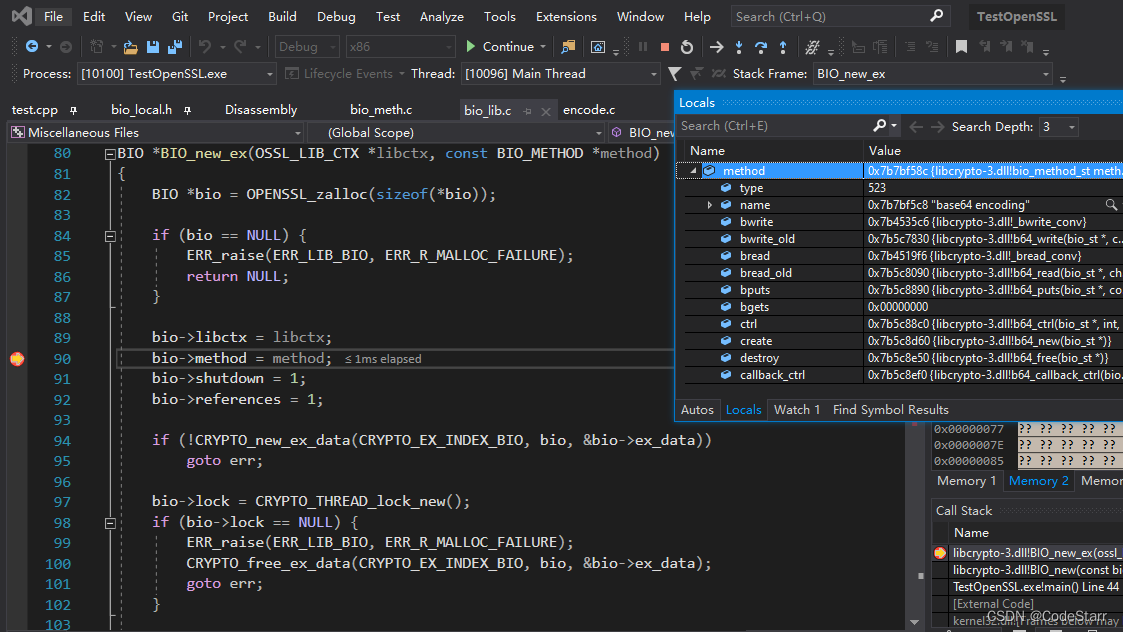
method->create为b64_new(),用于初始化bio->ptr==b64_ctx
// \crypto\evp\bio_b64.c
typedef struct b64_struct {
/*
* BIO *bio; moved to the BIO structure
*/
int buf_len;
int buf_off;
int tmp_len; /* used to find the start when decoding */
int tmp_nl; /* If true, scan until '\n' */
int encode;
int start; /* have we started decoding yet? */
int cont; /* <= 0 when finished */
EVP_ENCODE_CTX *base64;
char buf[EVP_ENCODE_LENGTH(B64_BLOCK_SIZE) + 10];
char tmp[B64_BLOCK_SIZE];
} BIO_B64_CTX;
函数栈如下:
> libcrypto-3.dll!b64_new(bio_st * bi) Line 71 C
BIO_B64_CTX *ctx;
//...
BIO_set_data(bi, ctx); // set bi->ptr
BIO_set_init(bi, 1); // initialized
libcrypto-3.dll!BIO_new_ex(ossl_lib_ctx_st * libctx, const bio_method_st * method) Line 104 C
if (method->create != NULL && !method->create(bio)) {
// ...
goto err;
}
if (method->create == NULL)
bio->init = 1; // 若没有单独的create初始化函数,则直接设置init标志
libcrypto-3.dll!BIO_new(const bio_method_st * method) Line 122 C
return BIO_new_ex(NULL, method);
TestOpenSSL.exe!main() Line 44 C++
构造BIO链
源码位置:\crypto\bio\bio_lib.c
// BIO_push(b64, bio);
BIO *BIO_push(BIO *b, BIO *bio)
{
BIO *lb;
if (b == NULL)
return bio;
lb = b;
while (lb->next_bio != NULL)
lb = lb->next_bio;
lb->next_bio = bio;
if (bio != NULL)
bio->prev_bio = lb;
/* called to do internal processing */
BIO_ctrl(b, BIO_CTRL_PUSH, 0, lb);
return b;
}
在BIO链表中,stdout source/sink BIO是在 base64 filter BIO之后的。
写数据
BIO_write(b64, message, strlen(message));
BIO_flush(b64);
再看一下methods_b64:
static const BIO_METHOD methods_b64 = {
BIO_TYPE_BASE64,
"base64 encoding",
bwrite_conv, // int (*bwrite) (BIO *, const char *, size_t, size_t *);
b64_write, // int (*bwrite_old) (BIO *, const char *, int);
//...
}
调用BIO_write,其实是调用base64 method的bwrite和bwrite_old函数,形成如下函数栈:
libcrypto-3.dll!EVP_EncodeInit(evp_Encode_Ctx_st * ctx) Line 156 C
libcrypto-3.dll!b64_write(bio_st * b, const char * in, int inl) Line 346 C
libcrypto-3.dll!bwrite_conv(bio_st * bio, const char * data, unsigned int datal, unsigned int * written) Line 77 C
ret = bio->method->bwrite_old(bio, data, (int)datal);
libcrypto-3.dll!bio_write_intern(bio_st * b, const void * data, unsigned int dlen, unsigned int * written) Line 362 C
ret = b->method->bwrite(b, data, dlen, &local_written);
libcrypto-3.dll!BIO_write(bio_st * b, const void * data, int dlen) Line 384 C
TestOpenSSL.exe!main() Line 47 C++
但经过调试,执行BIO_write后标准输出(就是屏幕)并没有回显,而最开始贴出调用栈的BIO_flush刷新缓冲区后才有回显,底层是调用BIO_ctrl()实现的,文档如下:
https://www.openssl.org/docs/man3.0/man3/BIO_flush.html
BIO_flush() normally writes out any internally buffered data, in some cases it is used to signal EOF and that no more data will be written.
函数栈如下:
libcrypto-3.dll!b64_write(bio_st * b, const char * in, int inl) Line 366 C
libcrypto-3.dll!b64_ctrl(bio_st * b, int cmd, long num, void * ptr) Line 490 C
libcrypto-3.dll!BIO_ctrl(bio_st * b, int cmd, long larg, void * parg) Line 579 C
ret = b->method->ctrl(b, cmd, larg, parg); // b64_ctrl()
TestOpenSSL.exe!main() Line 48 C++
free
BIO_free_all(b64);
这个函数的作用,猜也能猜的到,遍历链表逐个释放空间。
// \crypto\bio\bio_lib.c
void BIO_free_all(BIO *bio)
{
BIO *b;
int ref;
while (bio != NULL) {
b = bio; // 从第一个节点开始释放
ref = b->references;
bio = bio->next_bio;
BIO_free(b);
/*
Since ref count > 1, don't free anyone else.
意思是别人还在用 别删
*/
if (ref > 1)
break;
}
}
// 需要释放的东西还是很多的
int BIO_free(BIO *a)
{
int ret;
if (a == NULL)
return 0;
// 引用数减1
if (CRYPTO_DOWN_REF(&a->references, &ret, a->lock) <= 0)
return 0;
REF_PRINT_COUNT("BIO", a);
if (ret > 0)
return 1;
REF_ASSERT_ISNT(ret < 0);
if (HAS_CALLBACK(a)) {
ret = (int)bio_call_callback(a, BIO_CB_FREE, NULL, 0, 0, 0L, 1L, NULL);
if (ret <= 0)
return 0;
}
if ((a->method != NULL) && (a->method->destroy != NULL))
a->method->destroy(a); // b64_free()
CRYPTO_free_ex_data(CRYPTO_EX_INDEX_BIO, a, &a->ex_data);
CRYPTO_THREAD_lock_free(a->lock);
OPENSSL_free(a);
return 1;
}


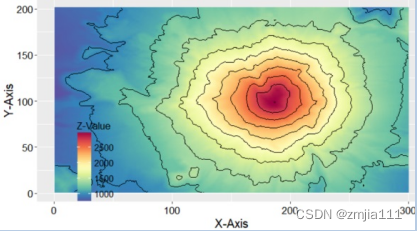
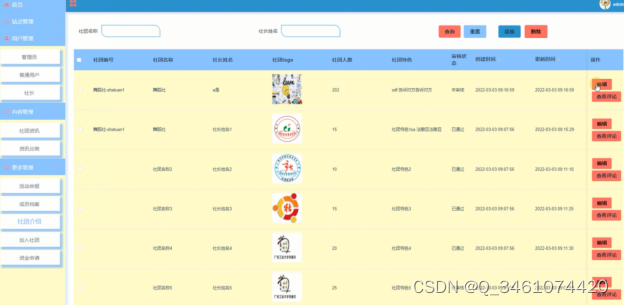
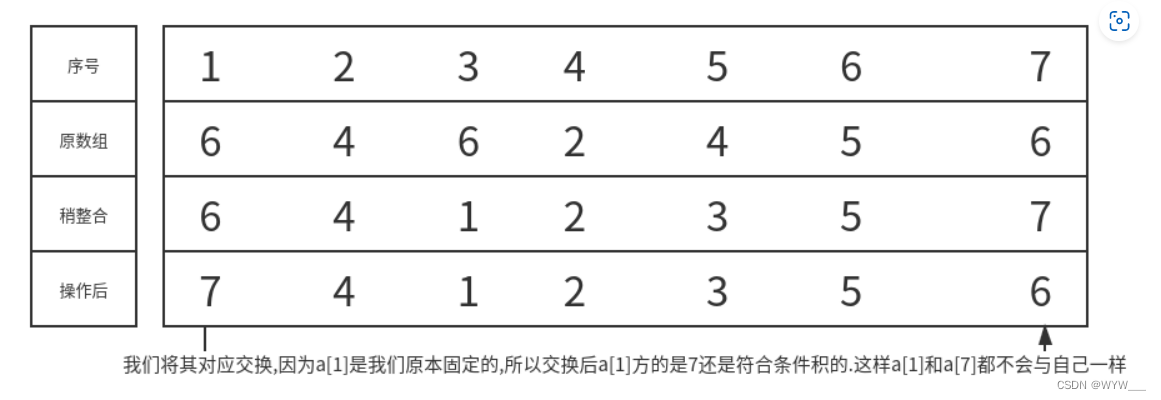

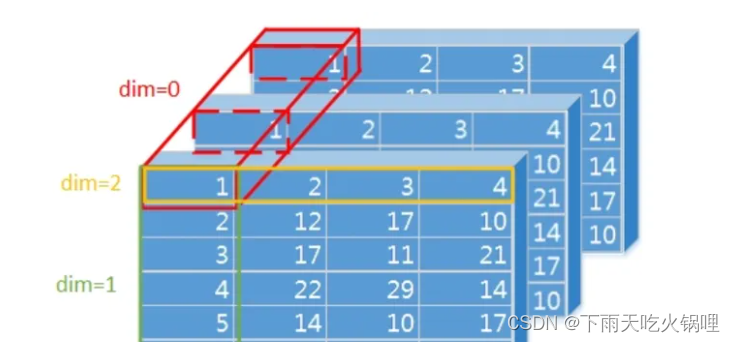
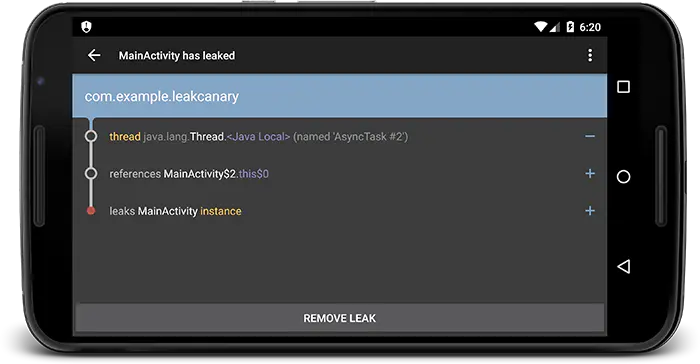

![[附源码]Python计算机毕业设计Django学习互助辅助系统](https://img-blog.csdnimg.cn/4d856cd9ccd64ae891af1c73f6f4ec85.png)


